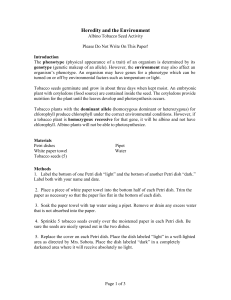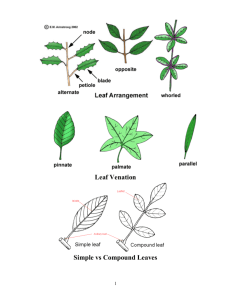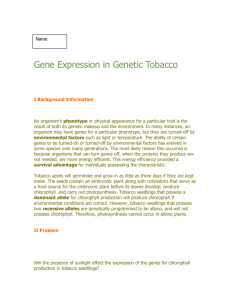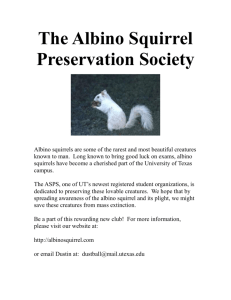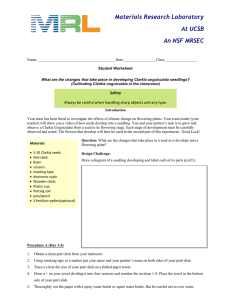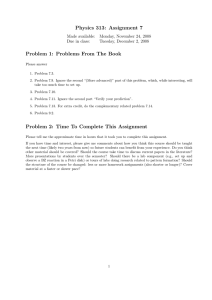Heredity and the Environment Lab - Tobacco Albino Seed Activity
advertisement
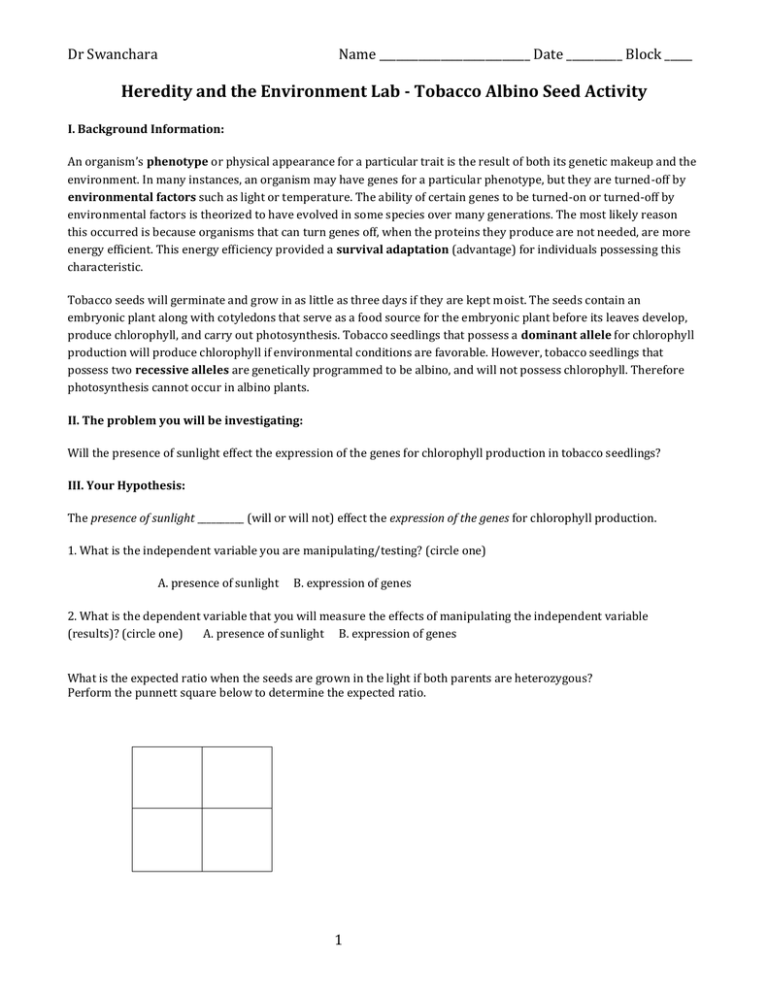
Dr Swanchara Name ___________________________ Date __________ Block _____ Heredity and the Environment Lab - Tobacco Albino Seed Activity I. Background Information: An organism’s phenotype or physical appearance for a particular trait is the result of both its genetic makeup and the environment. In many instances, an organism may have genes for a particular phenotype, but they are turned-off by environmental factors such as light or temperature. The ability of certain genes to be turned-on or turned-off by environmental factors is theorized to have evolved in some species over many generations. The most likely reason this occurred is because organisms that can turn genes off, when the proteins they produce are not needed, are more energy efficient. This energy efficiency provided a survival adaptation (advantage) for individuals possessing this characteristic. Tobacco seeds will germinate and grow in as little as three days if they are kept moist. The seeds contain an embryonic plant along with cotyledons that serve as a food source for the embryonic plant before its leaves develop, produce chlorophyll, and carry out photosynthesis. Tobacco seedlings that possess a dominant allele for chlorophyll production will produce chlorophyll if environmental conditions are favorable. However, tobacco seedlings that possess two recessive alleles are genetically programmed to be albino, and will not possess chlorophyll. Therefore photosynthesis cannot occur in albino plants. II. The problem you will be investigating: Will the presence of sunlight effect the expression of the genes for chlorophyll production in tobacco seedlings? III. Your Hypothesis: The presence of sunlight __________ (will or will not) effect the expression of the genes for chlorophyll production. 1. What is the independent variable you are manipulating/testing? (circle one) A. presence of sunlight B. expression of genes 2. What is the dependent variable that you will measure the effects of manipulating the independent variable (results)? (circle one) A. presence of sunlight B. expression of genes What is the expected ratio when the seeds are grown in the light if both parents are heterozygous? Perform the punnett square below to determine the expected ratio. 1 Dr Swanchara Name ___________________________ Date __________ Block _____ An expected ratio of green:albino is predicted to be ______________ for when the seeds are grown in a light environment. In the dark, however, the genotype cannot express itself due to the lack of light necessary for chlorophyll production. The seedlings will all look albino when grown in the dark. This change in gene expression ratio is due to ______________. This lab will investigate is the balance between heredity and the environment in determining what an organism will look like? Specifically what are the effects of the environment on albino tobacco seeds. A. Model: What things affect heredity in plants? Create a mind map or model of the things that can affect the expression of genes in seeds (HINT: think about what a plant needs to survive) Materials Water, tap 3 Disposable plastic petri dishes (100 x 15 mm) Filter paper, 9 cm, 2 Lightproof storage area or covers Marker Pipet Tobacco seeds 20/experimental group (from parents heterozygous for albinism) Procedure: 1. With a piece of tape: label the bottom of one Petri dish “light” ; the bottom of another Petri dish “dark. Label all with your group name and date. 2. Place a piece of moistened filter paper into the bottom half of each Petri dish. 3. Sprinkle 20 tobacco seeds evenly over the moistened paper in each Petri dish. Use a toothpick to spread out in the two dishes. 4. Replace the cover on each Petri dish. Place the dish labeled “light” in a well-lighted area under the grow lights. Place the dish labeled “dark” in a completely darkened area where it will receive absolutely no light. (place your Petri dish in the designated drawer for your class). Place your third petri dish in the area or environmental condition that your group has selected. 5. Allow the seeds to germinate for one week. Let the dishes sit undisturbed except to add water if the filter paper should become dry. If the dish in the dark needs added water, add it quickly and in a reduced light environment. (this is your groups responsibility – if your seeds dry out you will receive 0 for the results) 6. Observe the 3 Petri dishes at the end of one week. Some seedlings will be pale in color (albino) with little or no green pigment. Other seedlings will have green areas forming. When nearly all the seedlings have germinated, count each seedling as either green or albino. Record your results in the data table below: 2 Dr Swanchara Name ___________________________ Date __________ Block _____ V. Recording the results of the change in the independent variable on the dependent variable: Data Analysis Questions 1. What are the phenotypes of the tobacco seedlings growing in the light at the end of the experiment? 2. What are the phenotypes of the tobacco seedlings grown in the dark (before they were exposed to light)? 3. What are the phenotypes of the tobacco seedlings grown in the dark but then exposed to light for 24 hours? 4. From the data collected, what is the effect of light on the alleles for chlorophyll production? 5. Explain why did some of the seedlings in the light dish failed to produce chlorophyll and end up being albino? 6. Predict what will happen to the albino seedlings in the light dish by day 30 if growth was allowed to proceed. Explain: 7. Albino seedlings will not survive long enough to reproduce and pass their alleles on to the next generation. If this is so, explain how were albino seeds produced by the parent plants from which our seeds were harvested? 8. Were all of the tobacco seedlings that grew in the dark albino? ________. Explain your answer below: 3 Dr Swanchara Name ___________________________ Date __________ Block _____ 9. Is it energy efficient for plants to produce chlorophyll only when sunlight is present in the environment? ________ Explain: VI. Conclusion: 10. The experiment supports/does not support the hypothesis. 11. Explain how the data supports or refutes the hypothesis: 12. What possible sources of error could have interferer with your results? 13. Why is it important for scientists to use large sample sizes and repeat experiments? VII. Reflection and Application Questions: 14. Review the lab introduction. What do they mean by gene expression? 15. Why might it be beneficial to the plant to not express the chlorophyll gene when there is no light? 16. How do you know that the plants grown in the dark had the gene, but were not expressing it at the time? 17. Could the non-expressed gene be turned on later in time? How do you know? 4
